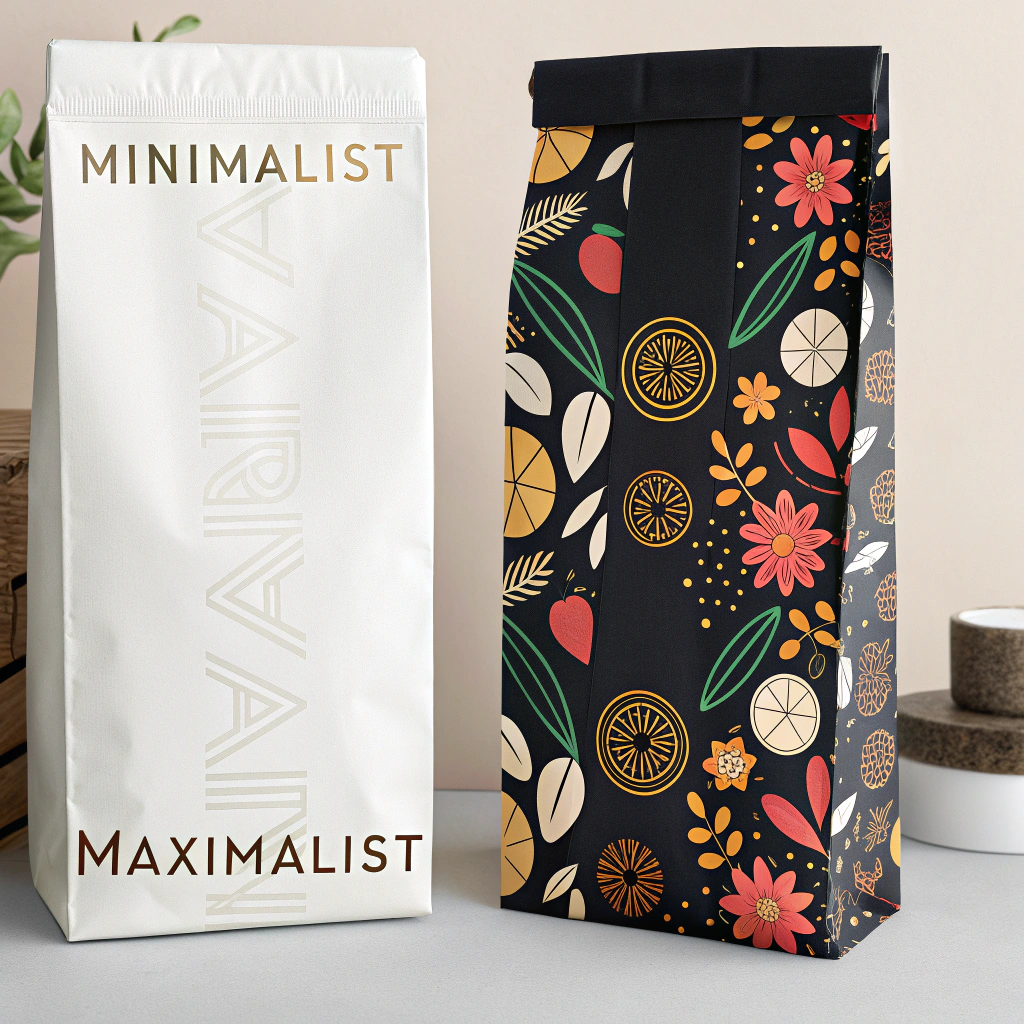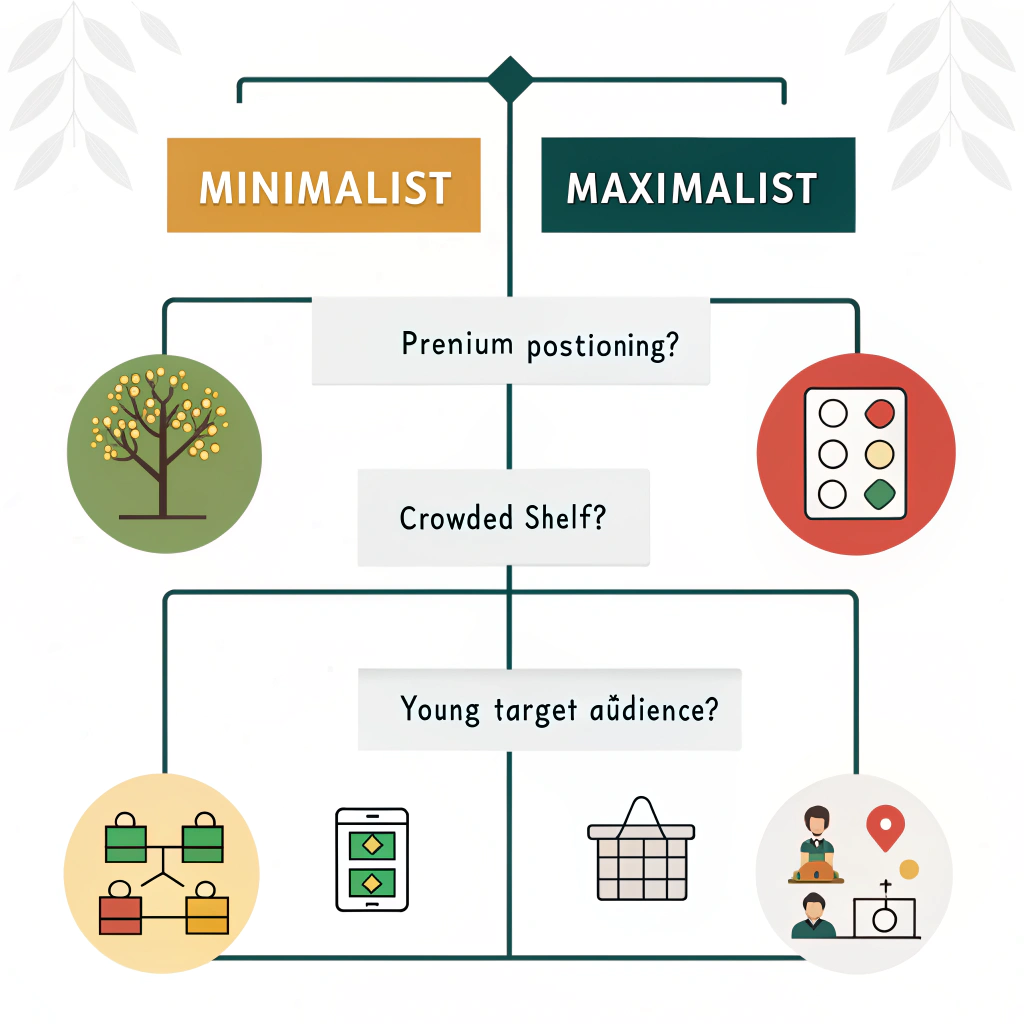Minimalist vs. Maximalist Packaging: When to Choose Each Approach
The packaging design spectrum spans from ultra-minimalist simplicity to bold maximalist expression. Both approaches can drive success, but choosing the wrong one for your brand and audience can be costly. Understanding when to embrace restraint versus when to go bold is crucial for packaging effectiveness.
Understanding the Philosophies
Minimalist packaging follows the “less is more” principle, using clean lines, limited color palettes, and essential elements only. It communicates sophistication, premium quality, and environmental consciousness through restraint.
Maximalist packaging embraces “more is more,” featuring vibrant colors, multiple textures, bold graphics, and abundant visual elements. It communicates energy, value, and brand personality through abundance.

The choice between minimalist and maximalist packaging reflects different brand philosophies and target audience preferences.
When Minimalist Packaging Wins
Premium Positioning Strategy
Minimalist packaging signals luxury and sophistication. Apple, Chanel, and Aesop use minimal design to communicate premium quality. The psychology: consumers associate simplicity with higher prices and better quality—a phenomenon called the “aesthetic premium.”
Success Case: Glossier Glossier’s millennial pink minimal packaging helped position the brand as a premium-yet-accessible beauty option. Clean typography and limited color palette created a cohesive brand experience that resonated with minimalism-loving millennials.
Sustainability-Conscious Markets
Minimal packaging often uses fewer materials and simpler production processes, appealing to environmentally conscious consumers. Brands like Ethique and Package Free Shop leverage minimalist design to reinforce their sustainability messaging.
Product-Focused Categories
When the product itself is the hero—like gourmet foods or handcrafted items—minimal packaging avoids visual competition. The packaging becomes a frame that highlights the product’s quality.
When Maximalist Packaging Dominates
Competitive Shelf Presence
In crowded retail environments, maximalist packaging cuts through visual noise. Cereal aisles, candy sections, and toy stores reward bold, attention-grabbing designs that stand out from dozens of competitors.
Success Case: Frito-Lay’s Flamin’ Hot Cheetos The bold red, orange, and black packaging with flame graphics perfectly matches the product’s intense flavor profile. Maximalist design reinforces the “extreme” positioning and appeals to thrill-seeking consumers.

Retail environment context heavily influences packaging effectiveness—minimalist designs excel in premium sections while maximalist approaches dominate competitive mass-market shelves.
Youth-Oriented Markets
Younger consumers often gravitate toward bold, expressive packaging that reflects their dynamic lifestyle. Energy drinks, gaming accessories, and fast fashion successfully use maximalist approaches to connect with Gen Z and millennial audiences.
Value Communication
Maximalist packaging can communicate abundance and value, suggesting customers get “more for their money.” Bulk products, variety packs, and discount brands often use busy designs to reinforce value propositions.
Hybrid Approaches: The Best of Both Worlds
Smart brands increasingly blend minimalist and maximalist elements strategically. This “selective maximalism” uses restraint as a foundation with bold accent elements for impact.
Success Case: Coca-Cola’s Limited Editions Coca-Cola maintains minimalist core branding (clean logo, consistent red) while adding maximalist seasonal elements. This approach preserves brand recognition while creating excitement around limited releases.
Decision Framework: Choosing Your Approach
Analyze Your Brand Positioning
- Premium/Luxury: Lean minimalist
- Accessible/Fun: Consider maximalist
- Technical/Professional: Favor minimalist
- Youth/Energy: Embrace maximalist
Consider Your Retail Environment
- High-end boutiques: Minimalist excels
- Mass retail/supermarkets: Maximalist competes better
- Online-first: Either works, test both
- Gift markets: Maximalist often preferred

Strategic packaging approach selection depends on brand positioning, target audience, and retail environment factors.
Understand Your Audience Demographics
- 35+ professionals: Often prefer minimalist
- 18-25 consumers: More open to maximalist
- Parents with children: Maximalist can attract attention
- Luxury consumers: Expect minimalist sophistication
Testing Your Approach
A/B Testing Strategies
Test both approaches with your target audience through:
- Focus groups with packaging mockups
- Online surveys with design preferences
- Retail pilot programs in select markets
- Social media polls for quick feedback
Success Metrics
- Sales performance in test vs. control groups
- Brand perception surveys before/after packaging changes
- Customer feedback and social media sentiment
- Market share changes in test categories
Implementation Considerations
Cost Implications
- Minimalist: Often lower printing costs, premium material costs
- Maximalist: Higher printing complexity, potential material savings
Production Complexity
- Minimalist: Simpler production, quality control critical
- Maximalist: Complex printing, color matching challenges
Brand Consistency
Both approaches require consistent application across all touchpoints. Mixed messaging confuses consumers and weakens brand equity.
Future Trends
The packaging landscape increasingly favors flexible approaches that can adapt to different contexts. Smart brands develop “packaging systems” that maintain core elements while allowing minimalist or maximalist expression as needed.
Sustainability pressure is pushing even maximalist brands toward more restrained approaches, while digital-first shopping reduces the need for shelf-impact packaging.
The most successful packaging strategies understand that neither minimalist nor maximalist is inherently superior—effectiveness depends entirely on strategic alignment with brand goals, audience preferences, and market context.
Choose your approach based on data, not design trends. Test thoroughly, and be prepared to evolve as markets change.
